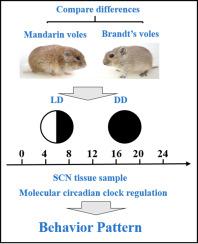Comparative Biochemistry and Physiology B: Biochemistry & Molecular Biology ( IF 2.2 ) Pub Date : 2020-07-18 , DOI: 10.1016/j.cbpb.2020.110478 Hong Sun 1 , Chuyi Li 2 , Yifeng Zhang 2 , Mengwan Jiang 2 , Qianqian Dong 2 , Zhenlong Wang 2

|
The behavioral circadian rhythms of subterranean rodents show intra- and interspecies diversity in terms of adaptation to dark underground environments, but the endogenous molecular mechanism of rhythm regulation in the suprachiasmatic nuclei (SCN) is stable to many species. In this study, we sought to determine the rhythms of behavior and central molecular regulatory mechanisms in the SCN of the subterranean Mandarin voles (Lasiopodomys mandarinus) compared with a related aboveground species, Brandt's voles (Lasiopodomys brandtii). Both species were reared under a 12 L:12 D cycle or in continuous darkness for 4 weeks. The pattern of wheel-running activity was similar in both species and had a periodicity of almost 24 h regardless of rearing conditions. However, the intensity of daily activity in Brandt's voles decreased markedly in darkness, while there was no significant difference in activity intensity in mandarin voles under different light regimes. In both vole species, all tested genes in the SCN showed significant time-dependent expression regardless of rearing conditions, and the expression levels of most genes did not differ significantly between different species and conditions. However, the peak phase shift in gene expression differed between the two species. In conclusion, behavioral patterns in mandarin and Brandt's voles were regulated by a stable molecular endogenous biological clock. The observed differences in activity intensity and phase shift suggest that different mechanisms regulate circadian rhythms in different living environments.
中文翻译:

光复位对两种田鼠物种(属:Lasiopodomys)的行为和中央生物钟的影响。
地下啮齿动物的行为昼夜节律在适应黑暗的地下环境方面表现出种内和种间多样性,但是在上交叉眼核(SCN)内节律调节的内源性分子机制对许多物种都是稳定的。在这项研究中,我们试图确定与相关地上物种布兰特田鼠(Lasiopodomys brandtii)相比,地下普通田鼠(Lasiopodomys mandarinus)的SCN的行为节律和中心分子调控机制)。将这两个物种在12 L:12 D周期或连续黑暗中饲养4周。在两个物种中,车轮行驶活动的模式均相似,并且无论饲养条件如何,其轮转周期均接近24小时。然而,在黑暗条件下,布兰特田鼠的日常活动强度明显降低,而普通田鼠的活动强度没有显着差异。在两种田鼠中,无论饲养条件如何,SCN中所有测试的基因均表现出明显的时间依赖性表达,并且大多数基因的表达水平在不同物种和条件之间没有显着差异。但是,两个物种之间基因表达的峰值相移有所不同。总之,普通话和布兰特的行为模式 田鼠由稳定的分子内源性生物钟调节。观察到的活动强度和相移的差异表明,在不同的生活环境中,不同的机制调节昼夜节律。


























 京公网安备 11010802027423号
京公网安备 11010802027423号